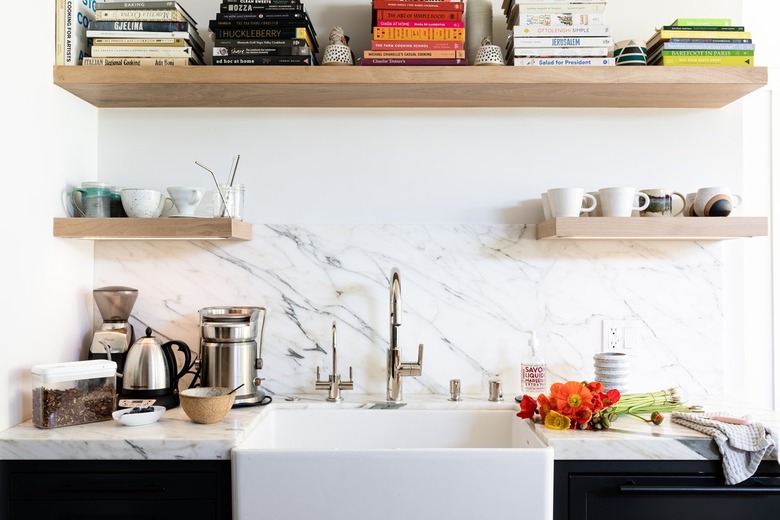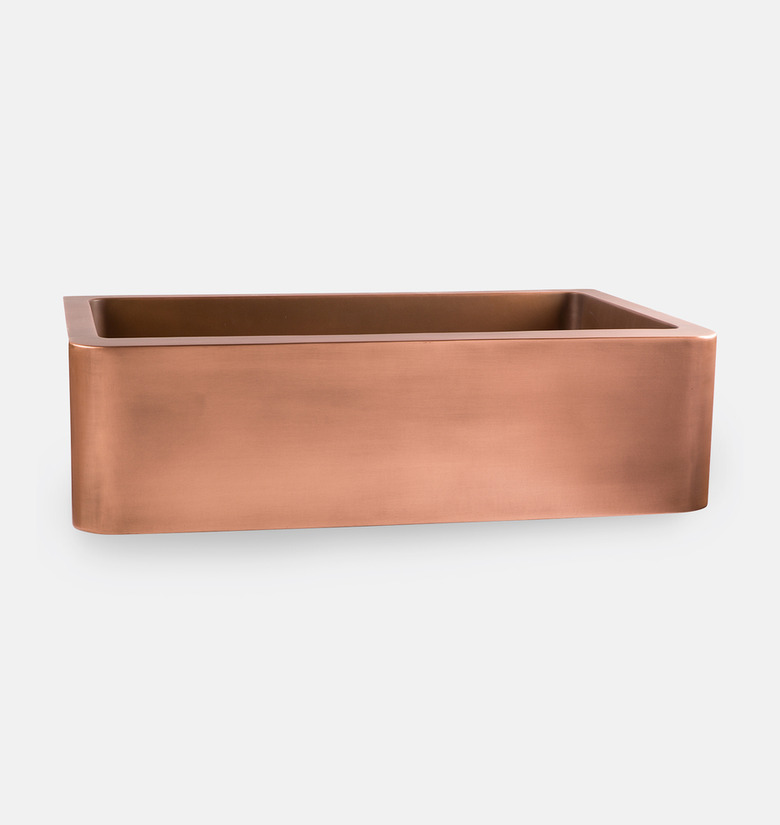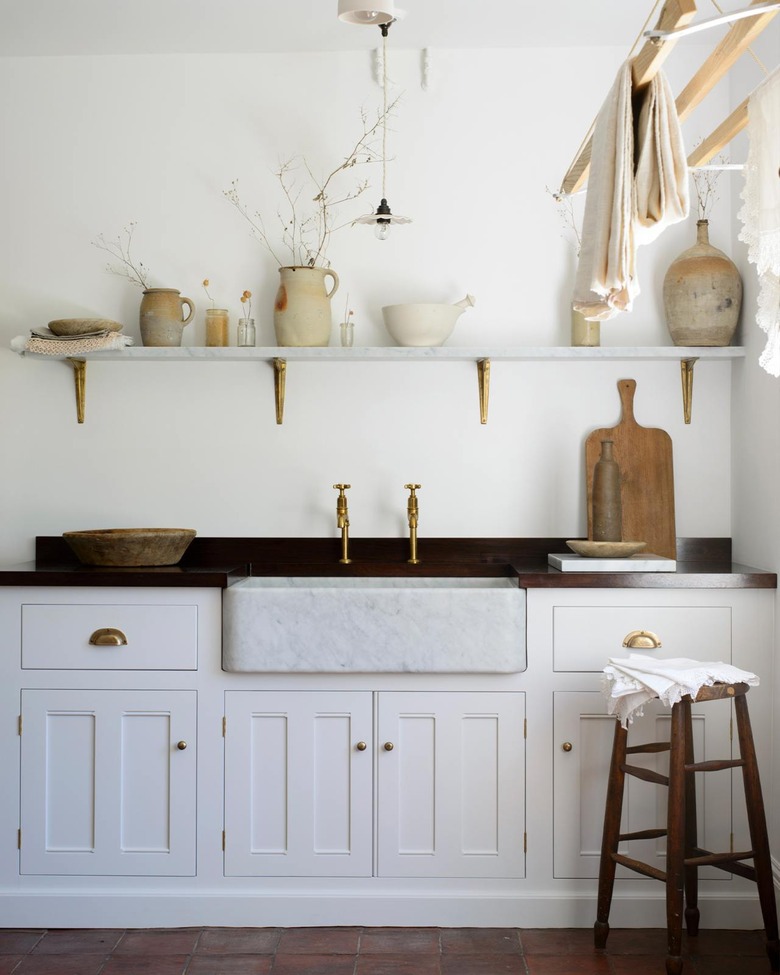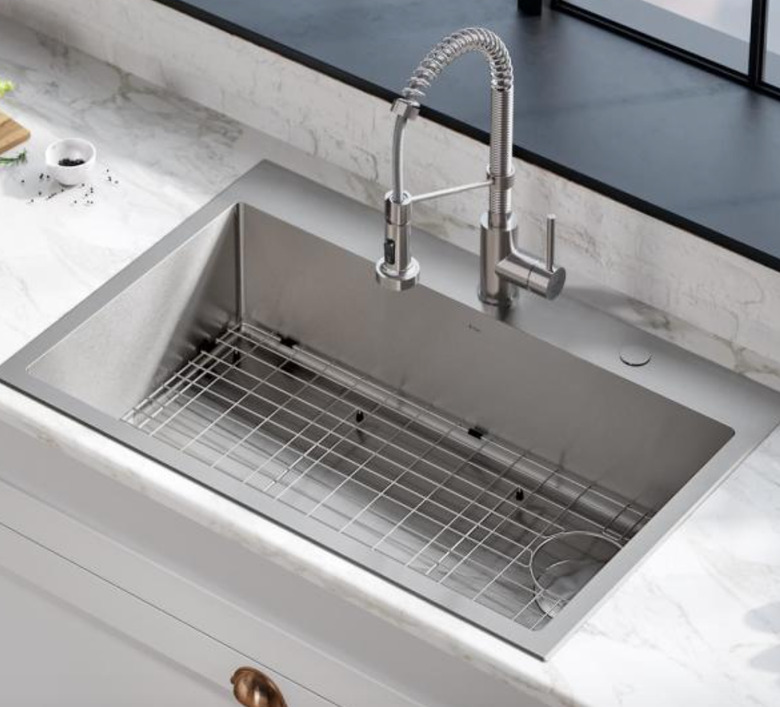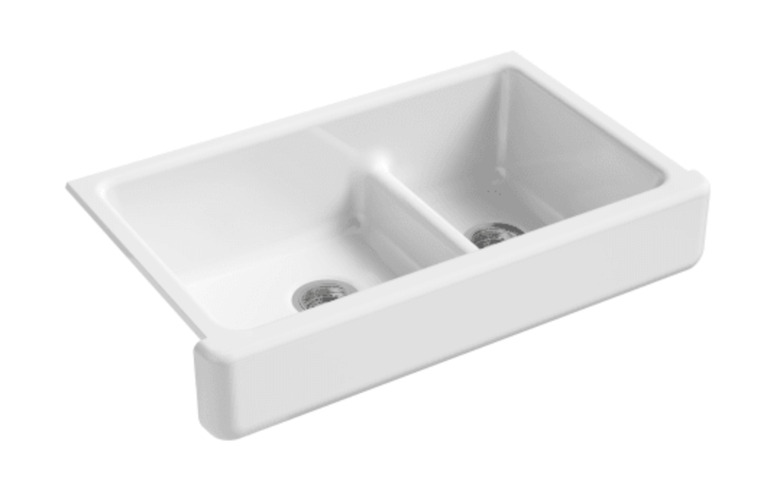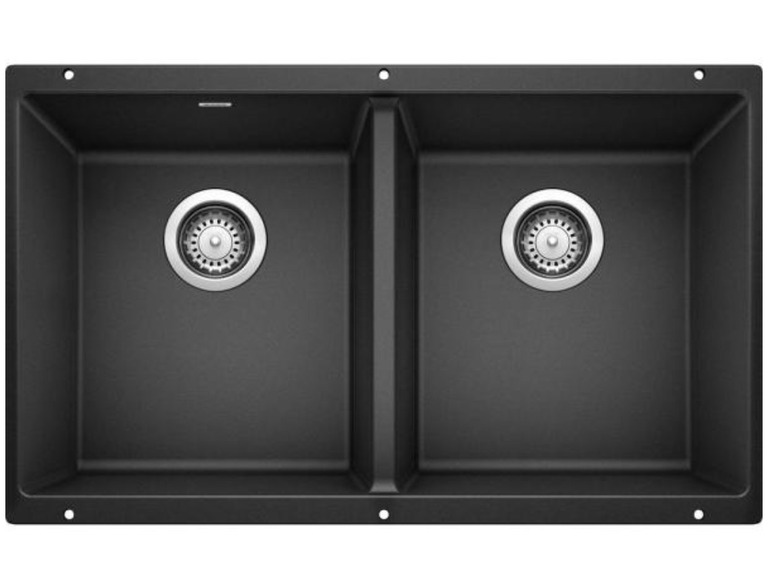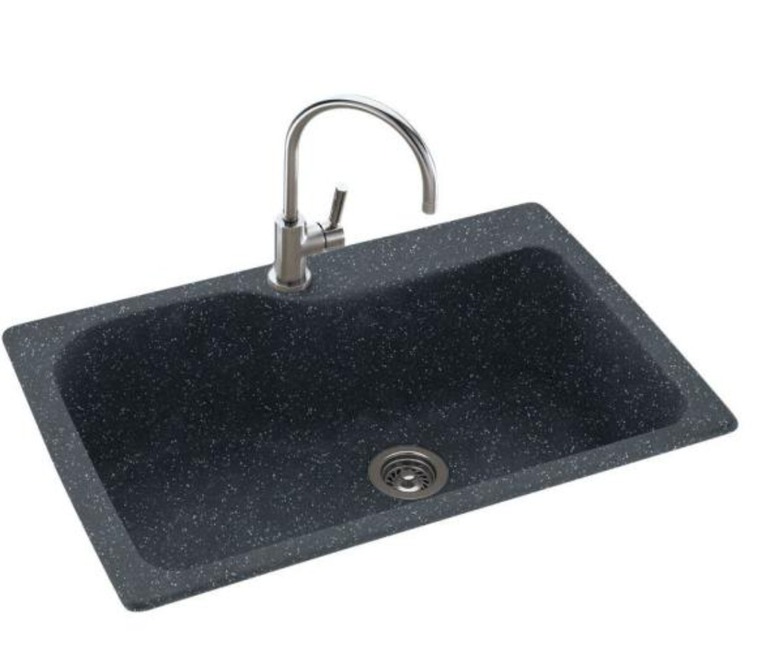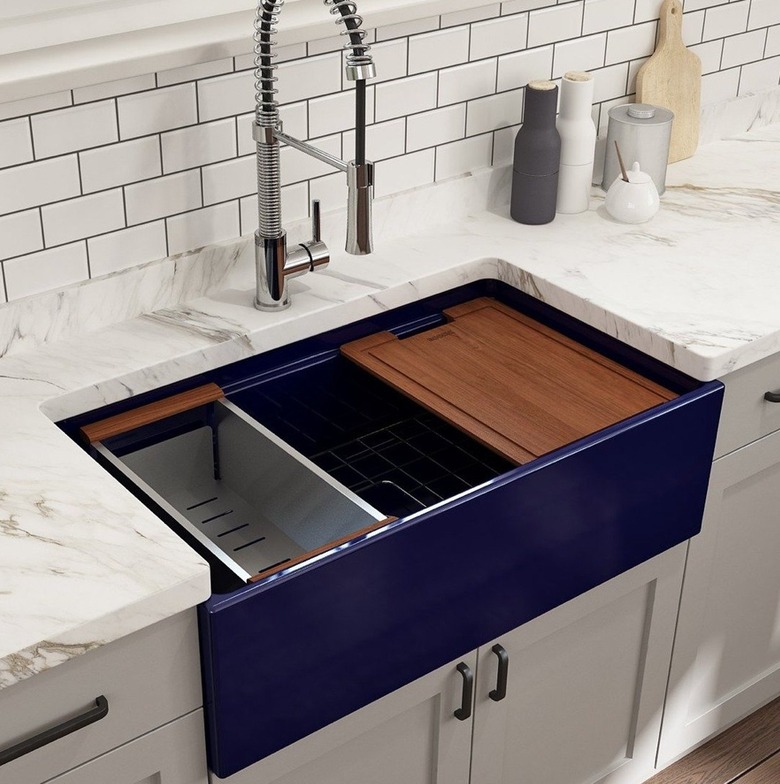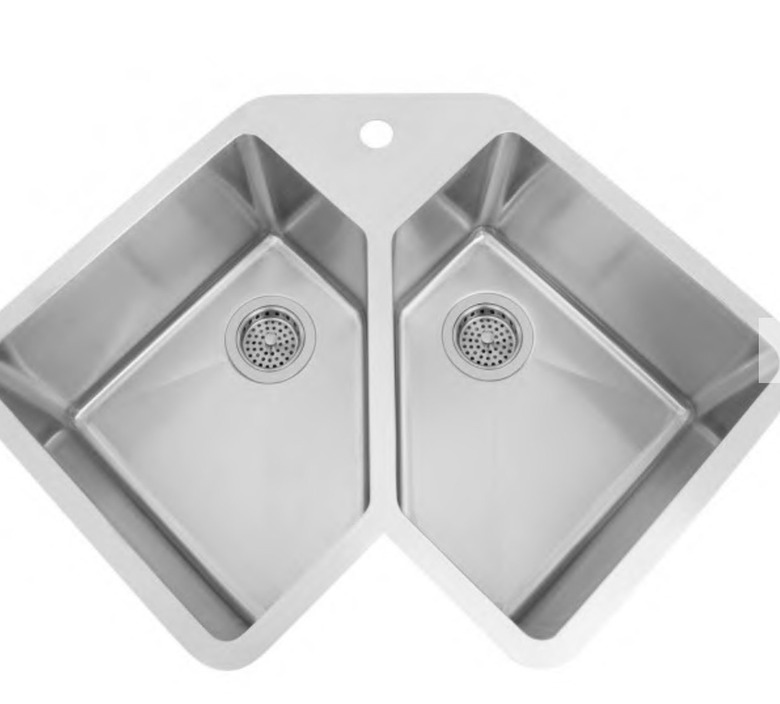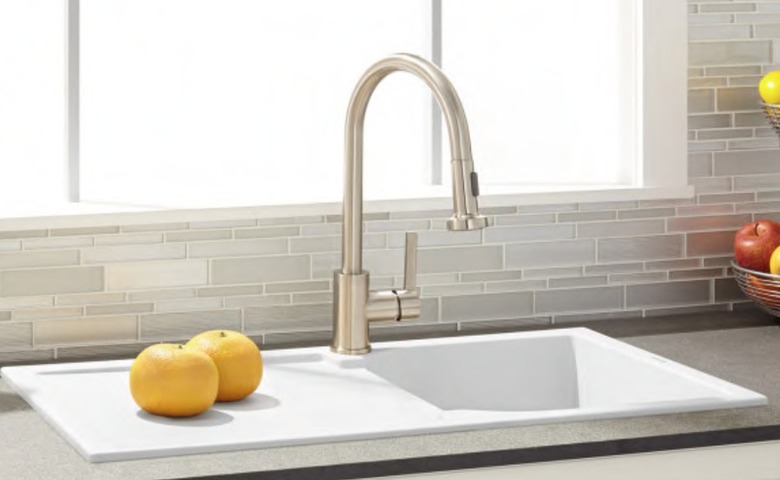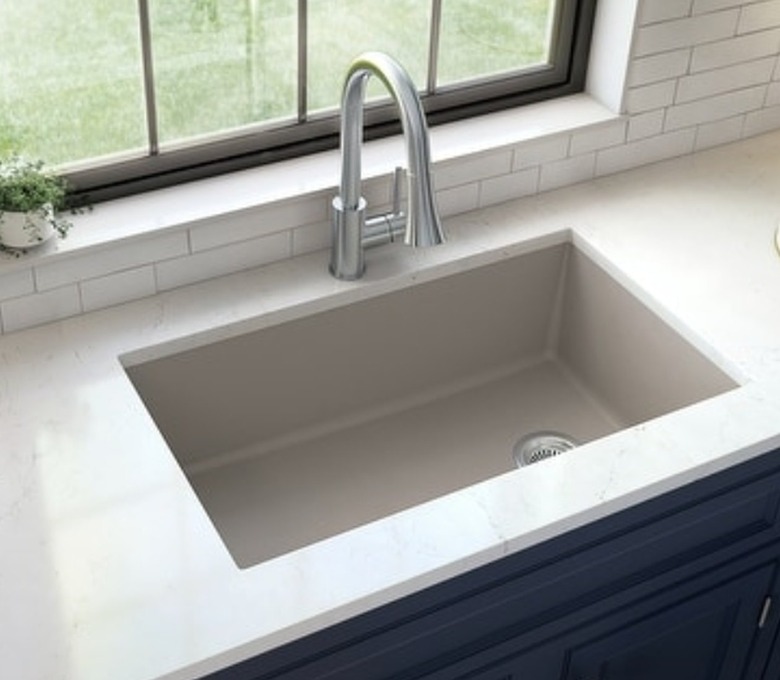11 Types Of Kitchen Sinks To Know Before Buying
Often considered more of a utilitarian, one-size-fits-all purchase, it's easy to overlook the design impact of the everyday kitchen sink. You may not realize that kitchen sinks actually come in a wide variety of configurations, materials, and styles — from drop-in to undermount, stainless steel to cast iron, and apron front to corner — just to name a few options. And while they might not be the first consideration when designing a cook space, kitchen sinks play a surprisingly important role when it comes to the overall look and feel of a kitchen.
Before you select a sink, it's important to take into account your lifestyle, cooking habits, and the number of people in your household. For example, are you an aspiring chef who enjoys preparing gourmet food for large groups? An oversize double bowl sink constructed from durable cast iron or fireclay is a hardworking option that can hold an abundance of dirty dishes, and it's easy to maintain. If you live alone, or have a spatially challenged kitchen, a deep single bowl stainless steel basin will do the trick, allowing you to set aside dirty plates and platters without crowding precious counter space. Or, are you creating the farmhouse kitchen of your dreams? In that case, a porcelain apron sink is equal parts practical and charming.
With so many options to choose from, it can be hard to know where to begin. But no need to worry, we've got you covered. To help narrow your search, here's a list of the most common types of kitchen sinks on the market.
1. Copper Sink
1. Copper Sink
If you doubt the impact of a kitchen sink, you've never never seen the culinary staple flaunting a copper finish. The look provides unparalleled warmth and elegance and functions as a design focal point. Use copper to punctuate a neutral cook space or amp up the drama of a traditional setup with layered patterns and color. Copper's a natural material that develops a rich patina over time, allowing the finish to alter. Cons: Copper sinks are pricey and thin copper will scratch and dent easily. Additionally, acidic materials can cause the patina to discolor, and some people may not appreciate the evolving tone.
Get the look: Rejuvenation Apron Front Copper Sink, $1,359
2. Fireclay Sink
2. Fireclay Sink
Fireclay sinks resemble cast iron enamel, but they have a protective coating that is baked on to the molded-clay base, so they're even more resistant to chips, stains, and scratches — you can even use abrasive cleaners on them. This heavy duty fabrication is reflected in the price, which tends to run higher than cast iron and porcelain. They come in different styles, but are often equated with farmhouse or apron-front sinks. Fireclay is organic and recyclable making it a feel-good purchase. Cons: If they are not installed correctly, fireclay sinks can chip and crack, especially around the drain.
Get the look: Rejuvenation Fireclay Kitchen Sink, $644
3. Marble Sink
3. Marble Sink
A custom marble sink, like this one from kitchen specialists deVOL, is no doubt an indulgence, but if you're looking to splurge on an enduring statement piece, a marble sink is it. Marble is a nuanced surface that will age and develop character, and is more susceptible to scratches and chips than other sink materials. It also requires specific cleaning products. Translation: If you'll be bothered by imperfections or are looking for something low maintenance, a marble sink is probably not right for you.
Get the look: deVOL Tuscan Farmhouse Carrara Marble Sink, starting at $4,015
4. Stainless Steel Sink
4. Stainless Steel Sink
Stainless steel sinks are one of the most popular choices thanks to their good looks, light weight, and ease of installation. They also infuse a sleek professional quality to kitchens (despite their modern undertones), and look equally at home with a variety of aesthetics, from industrial cook spaces to more traditional designs. Stainless steel sinks come in a range of thicknesses — counterintuitively, a thicker gauge means the sink will be heavier and cheaper, while a thinner gauge is lighter, sturdier, and pricier. Cons: Stainless steel sinks can dent easily and they tend to be louder, reverberating when anything is placed inside with a heavy hand — although some manufacturers incorporate sound-absorbing materials with their products. They're heat and stain resistant too, but water spots can be noticeable.
Get the look: Kraus Loften All-In-One Dual Mount Drop-In Stainless Steel Single Bowl Kitchen Sink, $349
5. Cast Iron Sink
5. Cast Iron Sink
Cast iron sinks obtain their appealing glossy finish from a sprayed porcelain coating, making them heavy and durable. They're available in a variety of colors from bright white to gray to blue and are the preferred style for use in farmhouse and country-inspired homes. Cons: Despite their durability, the finish can chip and abrasive cleaners can wear down the enamel coating exposing the underlying iron, which can rust. You also need to use caution when washing dishes since the hardness of this material can chip your dishware.
Get the look: Kohler Whitehaven Undermount Double Basin Cast Iron Kitchen Sink, $1,124.25
6. Granite Composite Sink
6. Granite Composite Sink
Granite composite sinks are constructed by combining crushed granite with resins resulting in an extremely durable, stain-resistant material. Granite composite sinks offer the look and feel of natural stone and, because the color goes all the way through, minor repairs are easy. They also have an inherent sound absorbing quality due to their density and are pretty easy to clean. Cons: If you're considering a granite composite sink, they're quite heavy and may require additional structural support. Plus, they're only available in a matte finish and they are quite heavy.
Get the look: Blanco Precis Undermount Granite Composite Double Bowl Kitchen Sink, $408.34
7. Solid Surface Sink
7. Solid Surface Sink
Solid surface sinks are made from the same man-made material used for solid surface countertops — synthetic sheets that are formed by combining a mineral compound with polyester and/or acrylic resins. They're available in a number of colors and provide a seamless transition from countertop to sink when used together — you can even have a coordinating drainboard fabricated. And bonus: Scratches can usually be sanded out. Cons: You can't place hot pots, pans, or dishes inside the sink.
Get the look: Swan Drop-In/Undermount Solid Surface Single Bowl Kitchen Sink, $257.58
8. Sink With Integrated Workstation
8. Sink With Integrated Workstation
Make food prep and clean up a cinch with a sink that has an integrated workstation. Many, including this cobalt fireclay version from Bocchi, include a removable cutting board, strainer, and colander. These are a great space-saving solution for kitchens lacking ample counter space.
Get the look: Bocchi Contempo Fireclay Workstation Farmhouse Sink, $787.50
9. Corner Sink
9. Corner Sink
If you are a small space-dweller, corner sinks are available as double basins and are installed on a corner of the counter. It's a less common design that's useful in maximizing limited counter space or an awkward corner. Cons: They can be expensive and difficult to install and since most counters are seamed at the corner this type of installation will require custom cuts, adding to the overall cost.
Get the look: Signature Hardware Infinite Corner Stainless Steel Undermount Sink, starting at $664
10. Drop-In Sink
10. Drop-In Sink
Drop-in or top-mount sinks are the most common, offer the easiest installation, and can work with any counter type regardless of the sink's weight. With a drop-in sink, the basin rests on the countertop leaving the rim visible. They come in a variety of materials and configurations — including double sink, stainless steel, and composite — with integrated features such as a drainboard, as seen in this design by Signature Hardware. Cons: They eat up precious counter space and food and grime can get caught on the lip of the sink.
Get the look: Signature Hardware Allardt Drop-in Granite Composite Sink with Integrated Drainboard, starting at $319
11. Undermount Sink
11. Undermount Sink
The edges of undermount sinks are concealed by the countertop, leaving a clean, seamless look without any rims for crumbs and other debris to get caught on. You can simply wipe dirt and grime off of the counter directly into the sink. Cons: Undermount sinks are supported by clips and fasteners that are attached to the underside of the countertop making some heavy sinks a challenge.
Get the look: Karran Undermount Quartz Single Bowl Kitchen Sink, $254.24
